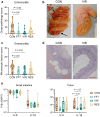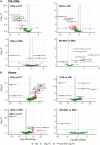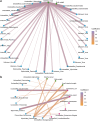Fecal virus-like particles are sufficient to reduce necrotizing enterocolitis
- PMID: 39172643
- PMCID: PMC11346570
- DOI: 10.1080/19490976.2024.2392876
Fecal virus-like particles are sufficient to reduce necrotizing enterocolitis
Abstract
Fecal filtrate transfer (FFT) is emerging as a safer alternative to traditional fecal microbiota transplantation (FMT) - particularly in the context of necrotizing enterocolitis (NEC), a severe gastrointestinal condition affecting preterm infants. Using a preterm piglet model, FFT has demonstrated superiority over FMT in safety and NEC prevention. Since FFT is virtually devoid of bacteria, prokaryotic viruses (bacteriophages) are assumed to mediate the beneficial effects. However, this assumption remains unproven. To address this gap, we separated virus-like particles (30 kDa to 0.45 µm) of donor feces from the residual postbiotic fluid. We then compared clinical and gut microbiota responses to these fractions with the parent FFT solution after transferring them to NEC-susceptible preterm piglets. Virome transfer was equally effective as FFT in reducing the severity of NEC-like pathology. The bacterial compositional data corroborated clinical findings as virome transfer reduced the relative abundance of several NEC-associated pathogens e.g. Klebsiella pneumoniae and Clostridium perfringens. Virome transfer diversified gut viral communities with concomitant constraining effects on the bacterial composition. Unexpectedly, virome transfer, but not residual postbiotic fluid, led to earlier diarrhea. While diarrhea may be a minor concern in human infants, future work should identify ways of eliminating this side effect without losing treatment efficacy.
Keywords: Fecal virome transplantation; bacteriophages; diarrhea; fecal microbiota transplantation; necrotizing enterocolitis; preterm.
Conflict of interest statement
No potential conflict of interest was reported by the author(s).
Figures







Similar articles
-
Protection against experimental necrotizing enterocolitis by fecal filtrate transfer requires an active donor virome.Gut Microbes. 2025 Dec;17(1):2486517. doi: 10.1080/19490976.2025.2486517. Epub 2025 Apr 10. Gut Microbes. 2025. PMID: 40207909 Free PMC article.
-
Fecal filtrate transplantation protects against necrotizing enterocolitis.ISME J. 2022 Mar;16(3):686-694. doi: 10.1038/s41396-021-01107-5. Epub 2021 Sep 22. ISME J. 2022. PMID: 34552194 Free PMC article.
-
Enteral broad-spectrum antibiotics antagonize the effect of fecal microbiota transplantation in preterm pigs.Gut Microbes. 2021 Jan-Dec;13(1):1-16. doi: 10.1080/19490976.2020.1849997. Gut Microbes. 2021. PMID: 33382952 Free PMC article.
-
Fecal virome transplantation: A promising strategy for the treatment of metabolic diseases.Biomed Pharmacother. 2024 Aug;177:117065. doi: 10.1016/j.biopha.2024.117065. Epub 2024 Jul 5. Biomed Pharmacother. 2024. PMID: 38971010 Review.
-
Faecal microbiota transplantations and the role of bacteriophages.Clin Microbiol Infect. 2023 Jun;29(6):689-694. doi: 10.1016/j.cmi.2022.11.012. Epub 2022 Nov 19. Clin Microbiol Infect. 2023. PMID: 36414201 Review.
Cited by
-
Protection against experimental necrotizing enterocolitis by fecal filtrate transfer requires an active donor virome.Gut Microbes. 2025 Dec;17(1):2486517. doi: 10.1080/19490976.2025.2486517. Epub 2025 Apr 10. Gut Microbes. 2025. PMID: 40207909 Free PMC article.
-
The role of the early-life gut microbiome in childhood asthma.Gut Microbes. 2025 Dec;17(1):2457489. doi: 10.1080/19490976.2025.2457489. Epub 2025 Jan 30. Gut Microbes. 2025. PMID: 39882630 Free PMC article. Review.
-
The neonatal gut microbiome in health and disease.Gut Microbes. 2025 Dec;17(1):2457499. doi: 10.1080/19490976.2025.2457499. Epub 2025 Jan 27. Gut Microbes. 2025. PMID: 39868670 Free PMC article. No abstract available.
References
-
- Cristofalo EA, Schanler RJ, Blanco CL, Sullivan S, Trawoeger R, Kiechl-Kohlendorfer U, Dudell G, Rechtman DJ, Lee ML, Lucas A, et al. Randomized trial of exclusive human milk versus preterm formula diets in extremely premature infants. J Pediatr. 2013;163(6):1592–1595.e1. doi: 10.1016/j.jpeds.2013.07.011. - DOI - PubMed
-
- Pammi M, Cope J, Tarr PI, Warner BB, Morrow AL, Mai V, Gregory KE, Kroll JS, McMurtry V, Ferris MJ, et al. Intestinal dysbiosis in preterm infants preceding necrotizing enterocolitis: a systematic review and meta-analysis. Microbiome. 2017;5(1):31. doi: 10.1186/s40168-017-0248-8. - DOI - PMC - PubMed
MeSH terms
LinkOut - more resources
Full Text Sources
Medical
Miscellaneous
